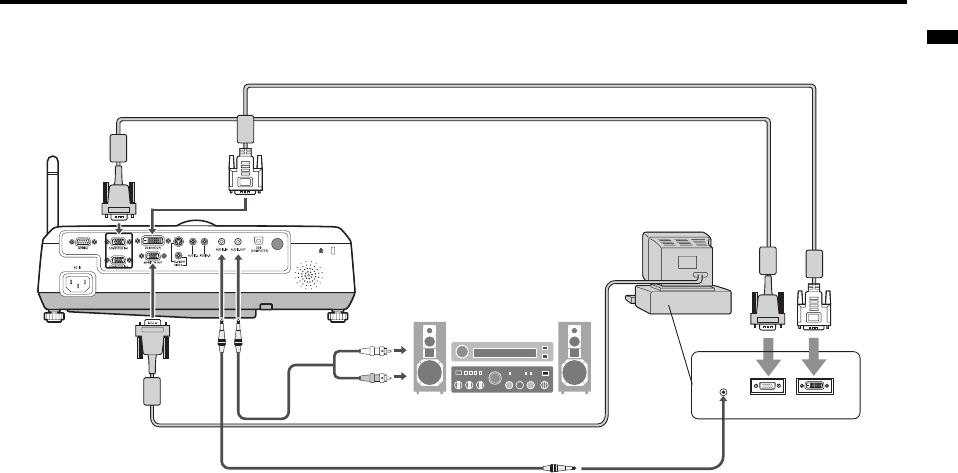
EN-13
ENGLISH
Basic connections (continued)
Projector + Computer
For computer with Mini D-SUB or DVI-D
For analog connection:
1. Connect one end of the supplied RGB cable to the COMPUTER-IN terminal (1, 2) of the projector.
2. Connect the other end of the RGB cable to the monitor port of the computer.
For digital connection:
1. Connect one end of the DVI-D cable to the DVI-D (HDCP) terminal of the projector.
2. Connect the other end of the DVI-D cable to the monitor port of the computer.
• If you start the computer first, images may not be displayed.
• The DVI-D (HDCP) terminal of this projector supports DDC2B. If the projector is connected to a computer which supports the standard, the com-
puter automatically reads out the information about the projector to output appropriate images.
• If the projector is connected to a computer which supports DDC, plug the power plug of the projector into the wall outlet, and then start the com-
puter.
• The DVI type that the projector supports is DVI-D (digital). DVI-A (analog) cannot be used with the projector.
• If a computer has a DVI-I (digital and analog) output connector, you can connect the projector with a DVI-D cable.
• Use the AUDIO-IN terminal for the audio input.
For monitor connection:
Connect the RGB cable from the monitor to the MONITOR OUT terminal of the projector.
• Images may not be displayed correctly depending on the type of the input signal. See the instruction manual of the monitor.
• Signals are coming from the COMPUTER-IN terminal (1 or 2) of the projector.
• When signals are coming from both COMPUTER-IN terminals (1, 2), images are projected from the terminal (1 or 2) currently or last selected in
the projector's menu.
Important:
• When you use a longer RGB cable instead of the provided cable, the image may not be projected correctly.
• Some computers require additional connectors or analog RGB output adapters to be connected with this projector. Contact your dealer for fur-
ther information.
• This projector uses stereo pin jack for its audio input. Check the type of the audio output terminal of the connected computer and prepare a
proper cable for connection. Some computers don’t have the audio output terminal.
• Speaker output is mono.
• When the audio cable is connected to the AUDIO-OUT terminal, the speaker output is muted.
• While the DVI-D terminal is being used or while an image is being projected wirelessly, you cannot use the MONITOR OUT terminal.
For Macintosh
• If your Macintosh has no video port, a monitor output adapter is required. Contact your dealer for further information.
• Some Macintoshes require a MAC adapter for the RGB cable for connection with this projector. Contact your dealer for further information.
About DDC
The COMPUTER/COMPONENT VIDEO IN-1 terminal of this projector complies with the DDC 1/2B standard. When a computer supporting this
standard is connected to this terminal, the computer will automatically load the information from this projector and prepare for output of appropriate
images.
• After connecting a computer supporting this standard to this terminal, plug the power cord of the projector in the wall outlet first, and then boot up
the computer.
AUDIO OUT
MONITOR OUTPUT DVI-D
COMPUTER-IN
RGB cable for PC
AUDIO-OUT
Audio cable (option)
MONITOR OUT
Necessary when outputting to both
a PC monitor and the projector.
PC audio cable (option)
AUDIO-IN
to PC audio output
Computer
to monitor port
RGB cable for PC (option)
DVI-D cable for PC
DVI-D (HDCP)
to DVI-D port


















